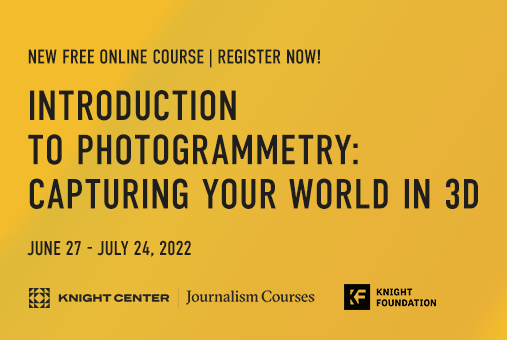
TIME used it to bring readers a picture of the destruction of the Amazon rainforest. Emblematic Group and PBS’ FRONTLINE used it to take viewers into the cell of an inmate in solitary confinement. The New York Times uses it to reconstruct journalistic scenes in 3D.
Photogrammetry allows journalists to tell stories about the world around them by creating three-dimensional replicas from photographs.
Learn more about the photogrammetric process and how it can be used for journalism in a new free online course from the Knight Center for Journalism in the Americas.
“Introduction to photogrammetry in journalism: capturing your world in 3D” is a massive open online course (MOOC) that will show you how to add the process to your digital toolkit.
The course, which is possible thanks to funding from the Knight Foundation, runs from June 27 to July 24, so register today!
“The point of the course is really about opening the door and helping people take a first step,” said Ben Kreimer, creative technologist and course instructor. “That first step is simply understanding what is photogrammetry and what are people doing with it.”
The course is divided into four weekly modules:
“When you hear about, talk about or think about these new three-dimensional mediums that are becoming more available – augmented reality, virtual reality or any kind of three-dimensional experience on the screen – photogrammetry is the most authentic way to capture the real physical world in 3D for those mediums,” Kreimer said.
He works with journalists, artists, scholars and mission-driven organizations on drones, 360° video, photogrammetric 3D reconstructions, spatial audio, volumetric video and other emerging media technologies. He is a former BuzzFeed Open Lab Beta Fellow and a consultant for projects funded by the National Science Foundation. He’s also done interdisciplinary work with Columbia University’s Tow Center for Digital Journalism, the Ford Foundation, USC Annenberg, the University of Nebraska’s Johnny Carson Center for Emerging Media Arts, and more.
To teach the course, Kreimer will interview guest speakers from around the world who use photogrammetry in their work. They include Chad Davis, chief innovation officer from Nebraska Public Media; Uttam Pudasaini, spatial technologies specialist and director of Nepal Flying Labs; India Johnson, owner of UAVistas LLC in Cleveland, Ohio, working in photogrammetric mapping, conservation, OpenDroneMap; and others.
“Journalists can learn a lot from not only other journalism projects, but from other industries and fields,” said Kreimer, who will bring a creative, interdisciplinary approach to the course and the use of photogrammetry.
No tools or applications are required for the course, but an Android or iOS smartphone, or digital camera and computer, will allow students to follow along with photogrammetry capture and processing exercises in modules 3 and 4. Additionally, students can use a free trial of photogrammetry capture and processing service Polycam for the exercises.
“We are very happy to offer this opportunity to journalists from around the world to enter the world of photogrammetry by learning the first steps to use 3D imagery to tell stories,” said professor Rosental Alves, founder and director of the Knight Center. “Since we started our distance learning program in 2003, we have helped thousands of journalists to learn new digital tools and techniques, so this course helps keep this tradition of pioneerism alive.”
The instructor will teach the course using video lectures, presentations, readings, discussion forums and quizzes.
The MOOC is asynchronous, meaning course activities can be completed on your own schedule, during the four-week period, from June 27 to July 24. There are recommended deadlines in place so you don’t fall behind.
Those who successfully complete course requirements and pay an administrative fee of US $30 can receive a certificate of participation at the end of the course. There is no formal credit of any kind associated with the certificate issued by the Knight Center.
So, register today for this interesting new online course and learn about the storytelling opportunities that can be unlocked with a helpful tool being tapped by journalists on the cutting edge of technology.

Knight Center for Journalism in the Americas
300 West Dean Keeton
Room 3.212
Austin, TX, 78712
Phone: 512-471-1391
Email: journalismcourses@austin.utexas.edu